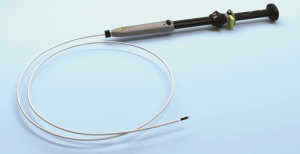por
Lauren Dubinsky, Senior Reporter | March 23, 2016

The AXIOS stent and
electrocautery enhanced
delivery system
Boston Scientific Corporation launched its AXIOS stent and electrocautery-enhanced delivery system today for use with two minimally-invasive pancreatitis procedures.
The system is cleared by the FDA for endoscopic management of pancreatic pseudocysts and certain kinds of walled-off pancreatic necrosis, which are two types of pancreatic fluid collections (PFCs) that occur in five to 16 percent of patients with acute pancreatitis and 20 to 40 percent of those with chronic pancreatitis. Even though some of those cases will resolve on their own, others lead to serious symptoms and require treatment.
Physicians can use the AXIOS system under endoscopic-ultrasound guidance to deploy the AXIOS stent in the PFC, which drains the PFC by forming a temporary passage between the PFC and gastrointestinal tract. The AXIOS stent is the only removable metal stent for PFC drainage available in the U.S., according to Boston Scientific.
"Imagine you have pancreatic enzymes that are literally digesting your insides — they're flowing and leaking out and they are compressing neighboring organs and now you stick a needle and place a stent, and the contents just gush out, and they are often infected, and you instantaneously change the patient's course," Dr. Kenneth Binmoeller of the California Pacific Medical Center and inventor of the AXIOS system, said in a video.
There is the option to treat PFCs with surgery, but it has led to high instances of morbidity and mortality. The endoscopic approaches are a less invasive treatment option that may lead to shorter hospital stays, better outcomes, and lower cost.
The University of North Carolina Hospital in particular has seen an improvement in procedural efficiency through reduced procedure times and patient exposure to X-ray imaging after deploying the AXIOS system. In addition, they also believe the AXIOS stent, which is larger in diameter than other stents, is helping them decrease the lengths of stays and the amount of interventions that are needed to manage PFCs.
"Interventional endoscopy is really about hand and eye coordination and understanding the tools that we use and being able to deliver and execute the maneuvers with great precision and great accuracy," said Binmoeller. "These are all skill sets in terms of using tools, and skill sets using imaging modalities, and they all complement one another."
In order to be a universal endoscopist, the physician needs to integrate all of those skill sets together and that is when they can dramatically change the course of a patient who is really sick, he added.
Back to HCB News
